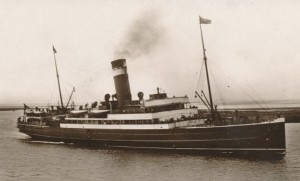HMS Duke of Albany

HMS Duke of Albany is a military vessel that was sunk during the First World War.
It came to rest off the Orkney Islands to the north of mainland Scotland. It is protected under the Protection of Military Remains Act 1986. After a diver illegally removed a porthole and an oval-shaped metal plate from the wreck in 2010, a successful prosecution was brought against him.
HMS Duke of Albany started out as a ferry running between Fleetwood and Belfast (at that time simply known as the Duke of Albany), but in the First World War she was commandeered by the Royal Navy, renamed HMS (Her or His Majesty’s Ship) Duke of Albany, and stationed around the Orkney Islands (Defence Policy and and Business 2011).
In 1916, she was attacked, sank (British Diver 2012), and the twenty-four sailors on board lost their lives (Defence Policy and and Business 2011). Hence the site of the wreck, some sixteen miles east of Old Head, South Ronaldsay (The Orcadian 2011), is also the ‘final resting place of those who lost their lives in national service’ (Sheriff Graeme Napier, quoted in The Orcadian 2011); a war grave. It is a Designated Vessel under the Protection of Military Remains Act 1986, recorded as sinking on 26 August 1916 (Ministry of Defence 2012).
In August 2010, divers visited the wreck site (The Orcadian 2011) and, apparently unaware of the law, one of the party removed two items from it – a porthole and a metal plate – intended as souvenirs of the dive (Mattock 2011). The Ministry of Defence Police (MDP) detectives first received a complaint from Navy Command, which followed ‘a referral by the Maritime and Coastguard Agency that a group of divers had visited the First World War wreck and illegally removed items from the war grave’ (Defence Policy and Business 2011). It was due to the discovery of images posted on Facebook that in September 2011 the MDP were able to visit the suspected diver, Duncan Keates, at his home in Leicestershire, to interview him under caution (Defence Policy and Business 2011).
In November 2011, Keates, having admitted removing the port hole and metal plate from the protected shipwreck was fined £1,400 at Kirkwall Sheriff Court (Defence Policy and Business 2011; The Orcadian 2011). The fine was lower than it could have been (the maximum penalty for illegal salvage in Scotland being £10,000 – Defence Police and Business 2011), apparently due to the defendant’s early admittance of guilt (The Orcadian 2011).
Several diving websites ran the story at the time, (e.g. British Diver 2012; Mattock 2011; Nineham 2011), with British Diver (2012) reminding enthusiasts to be aware of the law concerning protected wreck sites and advising them not to risk removing material if they are unsure of the status of the wreck that they are visiting. Defence Policy and Business (2011), part of the UK Ministry of Defence, noted that the assistance of members of the diving community ‘who had legitimately visited the wreck and seen…[the]…items in situ’ was instrumental in building the case against the offending diver (quoting Detective Sergeant Peter Cassidy).
The Protection of Military Remains Act 1986 protects from ‘unauthorised interference’ designated aircraft and vessel remains of UK origin that have sunk, crashed, or become stranded while in military service of the UK on or after 4 August 1914, and that rest in UK or international waters. The Act also protects any associated human remains, offering such sites protected war grave status (HMSO 1986).
References
British Diver (2012), ‘Man fined for porthole recovery’, (updated 03/02/2012) http://www.britishdiver.co.uk/2012/02/man-fined-for-porthole-recovery/, accessed 06/08/2012.
Defence Policy and and Business (2011), ‘War grave thief convicted’, (updated 22/11/11) http://www.mod.uk/DefenceInternet/DefenceNews/DefencePolicyAndBusiness/WarGraveThiefConvicted.htm, accessed 06/08/2012.
HMSO (1986), ‘Protection of Military Remains Act 1986’, London: Her Majesty’s Stationary Office.
Mattock, Jo (2011), ‘A diver has been fined £1,400 for removing a porthle and a metal plate from a First World War wreck’, Dive, http://www.divemagazine.co.uk/news/latest-news/5638-diver-fined-for-removing-porthole, (updated 8 November 2011), accessed 06/08/2012.
Ministry of Defence (2012), ‘The Protection of Military Remains Act 1986 (Designation of Vessels and Controlled Sites)’, London: Her Majesty’s Stationary Office.
Nineham, Laura (2011), ‘Diver fined for stealing from underwater war grave’, YBW.com http://www.ybw.com/news/motorboats/530194/diver-fined-for-stealing-from-underwa, accessed 07/08/2012.
The Orcadian (2011), ‘Visiting diver fined £1,400 for removing artefacts from protected WW1 wreck’, The Orcadian, 3 November 2011.




